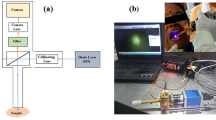Abstract
The demanding metabolic needs of cancer cells are met by aerobic glycolysis. While whole-body PET imaging methods exist for evaluating this metabolic response, these are not ideal for local, more detailed regions such as mucosal surfaces. Fluorescence imaging of glucose analogs with similarities to radiolabeled deoxyglucose used in PET, namely, fluorescent 2-deoxy-2-[(7-nitro-2,1,3-benzoxadiazol-4-yl)amino]-d-glucose (2-NBDG), offers such an alternative, particularly as this glucose analog may be delivered by local topical delivery. In this chapter, methods for in vivo epithelial imaging in a preclinical hamster model for oral cancer and oral epithelial dysplasia are described. Outlined are methods for preparation and in vivo delivery of 2-NBDG by topical application to the oral mucosa followed by fluorescence imaging to compare fluorescence responses between neoplasia and control mucosa or to monitor changes in fluorescence signal with time in both groups.
Access this chapter
Tax calculation will be finalised at checkout
Purchases are for personal use only
Similar content being viewed by others
References
Dang CV (2012) Links between metabolism and cancer. Genes Dev 26:877–890. https://doi.org/10.1101/gad.189365.112
Yuen CA, Asuthkar S, Guda MR, Tsung AJ, Velpula KK (2016) Cancer stem cell molecular reprogramming of the Warburg effect in glioblastomas: a new target gleaned from an old concept. CNS Oncol 5:101–108. https://doi.org/10.2217/cns-2015-0006
Sai KKS, Zachar Z, Bingam PM, Mintz A (2017) Metabolic PET imaging in oncology. Am J Roentgenol 209:270–276
Erdi YE (2012) Limits of tumor detectability in nuclear medicine and PET. Mol Imaging Radionucl Ther 21:23–28. https://doi.org/10.4274/Mirt.138
TeSlaa T, Teitell MA (2014) Techniques to monitor glycolysis. Methods Enzymol 542:91–114. https://doi.org/10.1016/B978-0-12-416618-9.00005-4
Zou C, Wang Y, Shen Z (2005) 2-NBDG as a fluorescent indicator for direct glucose uptake measurement. J Biochem Biophys Methods 64(3):207–215
Sheth RA, Josephson L, Mahmood U (2009) Evaluation and clinically relevant applications of a fluorescent imaging analog to fluorodeoxyglucose positron emission tomography. J Biomed Opt 14:064014. https://doi.org/10.1117/1.3259364
Nitin N et al (2009) Molecular imaging of glucose uptake in oral neoplasia following topical application of fluorescently labeled deoxy-glucose. Int J Cancer 124:2634–2642. https://doi.org/10.1002/ijc.24222
Pal R, Villarreal P, Qiu S, Vargas G (2018) In-vivo topical mucosal delivery of a fluorescent deoxy-glucose delineates neoplasia from normal in a preclinical model of oral epithelial neoplasia. Sci Rep 8:9760. https://www.nature.com/articles/s41598-018-28014-8#Ack1
Silverman J (2012) Chapter 29—biomedical research techniques. In: Suckow MA, Stevens KA, Wilson RP (eds) The laboratory rabbit, Guinea pig, hamster, and other rodents. Academic Press, Boston, pp 779–795
Gimenez-Conti I (1993) The hamster cheek pouch carcinogenesis model. Acta Odontol Latinoam 7:3–12
Vairaktaris E et al (2008) The hamster model of sequential oral oncogenesis. Oral Oncol 44:315–324. https://doi.org/10.1016/j.oraloncology.2007.08.015
Author information
Authors and Affiliations
Corresponding author
Editor information
Editors and Affiliations
Rights and permissions
Copyright information
© 2020 Springer Science+Business Media, LLC, part of Springer Nature
About this protocol
Cite this protocol
Villarreal, P., Pal, R., Vargas, G. (2020). In Vivo Epithelial Metabolic Imaging Using a Topical Fluorescent Glucose Analog. In: Basel, M., Bossmann, S. (eds) Cell Tracking. Methods in Molecular Biology, vol 2126. Humana, New York, NY. https://doi.org/10.1007/978-1-0716-0364-2_3
Download citation
DOI: https://doi.org/10.1007/978-1-0716-0364-2_3
Published:
Publisher Name: Humana, New York, NY
Print ISBN: 978-1-0716-0363-5
Online ISBN: 978-1-0716-0364-2
eBook Packages: Springer Protocols




